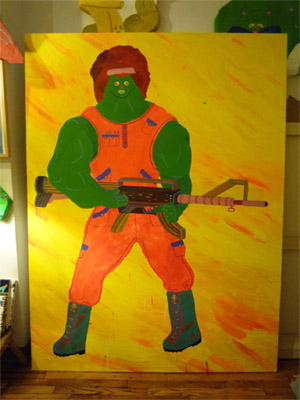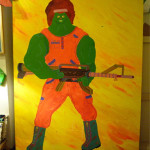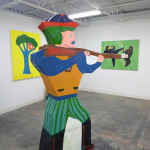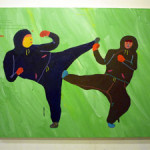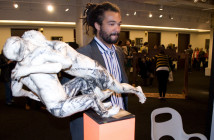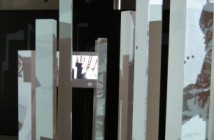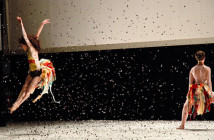MISAKI KAWAI @ LAMONTAGNE GALLERY
The paintings, sculptures and collages of "Kung Fu Forest," Misaki Kawai's current show at the LaMontagne Gallery, are simultaneously awesome and awkward, simplistic and compelling, endearing and inscrutable. Despite its insanely bright acrylic palette and undertones of violence, the show manages to be adorable, a testament to Kawai's trademark ability to infuse everything she creates with pure levity. As genderless humanoids and anthropomorphized forest creatures populate a variety of quasi-narrative situations, mostly to comic effect, Kawai's eye for detail adds texture and balance to a level of draftspersonship that is tempting to describe as crude. In the end, the success of the show has little to do with the works' meaning or message, since their unapologetically anti-cerebral nature frustrates attempts to read beyond their surfaces; rather, it is this nature itself which allows the viewer the emotional access required to appreciate them fully.
According to the gallery, the theme of "Kung Fu Forest" is "things that you would find in a forest," which is fair enough. (Kawai provides no artist's statement.) The show comprises 13 paintings, three sculptures and 12 collages, with innocuous titles such as "Aqua Fresh," "Mango Spirit" and "Banana Hunter." In "Mr. Lumber Thumber," (not a typo) a typical painting for the exhibition, a logger with an axe stands over a section of a cut tree, while a small squirrel looks on. Two things are immediately noticeable about this painting: the color and the perspective. The logger, of no discernable gender and with a totally vacant countenance, has sea foam green skin, blue lips, yellow eyes and a purple Jheri curl; the log ze1 stands on is hot pink with a purple grain. Kawai's fondness for color and pattern is clear in her juxtaposition of these shades with the logger's fabulous get-up: red and blue plaid shirt, yellow pants with aqua spots. Meanwhile, the picture's perspective is off, confusing the sizes of things: the axe blade is the bigger than hir head; the huge fist that grips the handle is the size of hir scrunched-up face; the unoccupied hand resting on hir hip is a withered stump. The logger and log exist within an infinite color field of different shades of green, and in this zone, objects are arranged not according to the laws of planar perspective, but by artistic fiat, as in the art of a child.
These choices reflect Kawai's overall indifference to representational realism, which frees the works to be quirky and distinctive and hence more approachable. The photonegative palette makes the canvases pop, and while the renderings of figures lack nuance – for example, a chin will be represented by a thin line painted across a figure's neck – the works themselves are chock-full of wonderful details. "Gum Ball Shot," a sculpture of a soldier firing a rifle, features swatches of plaid fabric as the back pockets of hir pants, synthetic puffballs on hir jacket and hat, and delicately striped slacks. The sculpture's technical execution, however, is hilarious: 11 inches of plaster separate two flat sides, 5'10" high, painted to look like the soldier's front and back. Both sides show one eye and half an open mouth, indicating that the soldier is looking forward; facing him head-on from the barrel of hir gun, however, the viewer sees both eyes and mouth repainted on the 11-inch wide median strip that, from this angle, represents hir face in two dimensions. The artist is clearly aware that people don't have four eyes; rather, her portrayal of the soldier in this way is analogous to her use of sky blue as a skin tone or her disregard for perspective. That is, all three indicate that her artistic priorities fall on the side of energy and fun rather than technique or depth.
The real reason "Kung Fu Forest" is eminently approachable has less to do with Kawai's pretty palette or cute figuration than with the nature of the works themselves. Rather than evincing technical mastery or thematic trenchancy, which they don't, the works remind the viewer of his or her own early experiences making art: how nothing comes out looking as it should; how the crayons/markers/colored pencils don't come in enough shades to get skin tones right; how difficult it is to render something convincingly in three dimensions. (The sculptures, moreover, are essentially large dioramas.) At the same time, Kawai's style embodies not only the awkwardness and cuteness of a child's attempts at art, but also its unshakeable conviction and surety of itselfas art. This is its true success: in staying simple, fun and childlike, it cuts through all discussions about the nature or definition or purpose of art – the types of discussions that produce the types of work that deter mainstream audiences from visiting galleries – and is able to be itself: energetic, spunky, raw and - best of all - easily appreciable. Of course, the irony is that in doing so she actively contributes to the discussions mentioned above, which takes her work from good to great.
Interestingly, "Kung Fu Forest" is paired with a small show in the gallery's project space by Andrew Mowbray, entitled "I Know Now." Mowbray's pieces, including illuminated framed boxes of "ancient" indigenous arrowheads made from beige polyethylene, explore the alienation of art objects in museums from their original purposes and meanings. While interesting on its own terms and very well executed, "I Know Now", when compared to "Kung Fu Forest," is an overly intellectualized snooze. Whereas Mowbray merely editorializes, Kawai offers energetic art whose marriage of form and function may serve as the basis for authentic critical reflection – all without over-thinking it.
- Misaki Kawai, Tropical Fighter, 2009.
- Misaki Kawai, Hunter, Acrylic, Fabric, Cardboard, Styrofoam, Wood, 2009.
- Misaki Kawai, Cherry Fighters, 2009.
1 Non-gendered pronouns reference non-gendered characters. Ze = she/he, hir = his/her.
"Misaki Kawai and Andrew Mowbray" is on view February 21 - March 28, 2009 at LaMontagne Gallery.
All images are courtesy of the artist and LaMontagne Gallery.

